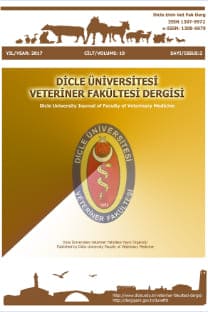Klinik Olarak Solunum Sistemi Hastalığı Geliştirdikleri Saptanan Sığırlarda Fasciolazis İnvazyonunun Görülme Sıklığı ve Hastalığın Bazı klinik ve Hematolojik Parametreler Üzerine Etkisi
Bulgular, fasciolazis, hematolojik, klinik, sığır
___
- 1. Snowder G, Van Vleck LD, Cundiff L, Bennett G. (2006). Bovine Respiratory Disease in Feedlot Cattle: Environmental, Genetic, and Economic Factors. J Anim Sci. 84: 1999-2008.
- 2. Closs G, Dechow C. (2017). The Effect of Calf-Hood Pneumonia on heifer Survival and Subsequent Performance. Livestock Sci. 205: (5), 5-9.
- 3. Krump L, Hamilton CM, Sekiya M, O’Neill R, Mulcahy G. (2014). The Effect of Fasciola Hepatica Infection on Respiratory Vaccine Responsiveness in Calves. Vet Parasitol. 201: 31–39.
- 4. Perino L, Hunsaker B. (1997). A Review of Bovine Respiratory Disease Vaccine Field Efficacy. Bovine Pract. 31: 59–66.
- 5. Blood DC, Radostits OM. (2007). Veterinary Medicine. Bailliere Tindall, London.
- 6. Boyunaga H, Schmitz MG, Brouwers JF, Van Hellemond JJ, Tielens AG. (2001). Fasciola Hepatica Miracidia Are Dependent on Respiration and Endogenous Glycogen Degradation for Their Energy Generation. Parasitology. 122(2) :169-73.
- 7. Kullberg M, Pearce E, Hieny S, Sher A, Berzofsky J. (1992). Infection with Schistosoma Mansoni Alters Th1/Th2 Cytokine Responses to a Nonparasite Antigen. J Immunol. 148: 3264-3270.
- 8. Anthony RM, Rutitzky LI, Urban JF, Stadecker MJ, Gause WC. (2007). Protective Immune Mechanisms in Helminth Infection. Nat Rev Immunol. 7: 975–987.
- 9. Elliott DE, Weinstock JV. (2012). Helminth-Host Immunological Interactions: Prevention and Control of Immune-Mediated Diseases. Ann NY Acad Sci. 1247: 83-96.
- 10. Mishra PK, Patel N, Wu W, Bleich D, Gause WC. (2013). Prevention of Type 1 Diabetes Through Infection with an Intestinal Nematode Parasite Requires Il-10 in the Absence of a Th2-Type Response. Mucosal Immunol. 6:297-308.
- 11. Salgame P, Yap GS, Gause WC. (2013). Effect of Helminth-Induced Immunity on Infections with Microbial Pathogens. Nature Immunol. 14(11): 1118-1126. 12. Zaccone P, Burton O, Miller N, Jones FM, Dunne DW, Cooke A. (2009). Schistosoma Mansoni Egg Antigens Induce Treg That Participate in Diabetes Prevention in NOD Mice. Eur J Immu-nol. 39:1098-1107.
- 13. Brady MT, O'Neill SM, Dalton JP, Mills KH. (1999). Fasciola Hepatica Suppresses a Protective Th1 Response Against Bordetella Pertussis. Infect Immun. 67(10): 5372-5378.
- 14. Flynn RJ, Mannion C, Golden O, Hacariz O, Mulcahy G. (2007). Experimental Fasciola hepatica Infection Alters Responses to Tests Used for Diagnosis of Bovine Tuberculosis. Infect Im-mun. 75(3): 1373-1381.
- 15. Resende COT, Hirsch CS, Toossi Z, Dietze R, Ribeiro-Rodrigues R. (2007). Intestinal Helminth Co-Infection Has a Negative Impact on both Anti-Mycobacterium Tuberculosis Immunity and Clinical Response to Tuberculosis Therapy. Clin Experim Immunol. 147(1): 45–52.
- 16. Cawdery M, Ruane M. (1971). Sedimentation Method for the Demonstration of the Eggs of Fasciola Hepatica in Faeces. Lab Pract. 20: 935-941.
- 17. Özkan AT, Korkmaz M, Kuman A, Ayçiçek H, Tanyüksel M. (2005). Fascioliasis Tanısında Erişkin Antijeni ile PBS ve RPMI 1640’da Elde Edilen Ekskresyon/Sekresyon Antijenlerinin Elisa Yöntemiyle Karşılaştırılması. T Hij Den Biyol Derg. 62 (1): 17 -26.
- 18. Sesen R, Yıldırım M. (1993). Parazitolojik Önemi Olan Türkiye Tatlı Su Salyangozları Üzerine Bir Çalışma. T Parazitol Derg. 17(3-4) : 138-147.
- 19. Kara M, Gicik Y, Sari B, Bulut H, Arslan M. (2009). A Slaughter-house Study on Prevalence of Some Helminths of Cattle and Sheep in Malatya Province, Turkey. JAVA. 8(11): 2200-2205.
- 20. Ayaz KC. (2014). Bolu Yöresinde Fasciolosis’in Seroprevalansı. Yüksek Lisans Tezi, Abant İzzet Baysal Üniversitesi, Bolu.
- 21. Aksoy DY, Kerimoğlu U, Oto A, et al. (2006). Fasciola Hepatica Infection: Clinical and Computerized Tomographic Findings of Ten Patients. Turk J Gastroenterol. 17: 40–45.
- 22. Teichmann D, Grobusch MP, Göbels K, Müller HP, Koehler W, Suttorp N. (2000). Acute Fascioliasis with Multiple Liver Abscesses. Scand J Infect Dis. 32: 558–560.
- 23. Aliaga L, Diaz M, Quiroga J. (1984). Eosinophilic Pulmonary Disease Caused by Fasciola Hepatica. Description of a Case and Review of the Literature. Med Clin (Barc). 82: 764-7.
- 24. King CH. (2007). Flukes (Liver, Lung and Intestinal). In: Klieg-man RM, Behrman RE, Jenson HB, Stanton BF (eds). Nelson Textbook of Pediatrics (18th ed). WB Saunders Elsevier, Philadelphia, USA.
- 25. Sezgi C, Cicek M, Sen HS, Kaya H, Taylan M, Abakay A, Abakay O, Dusak A, Tanrıkulu AC. (2013). Pulmonary Findings in Pa-tients with Fascioliasis. Acta Medica Mediterranea. 29: 841-847.
- 26. Tielens AG, van den Heuvel JM, van den Bergh SG. (1982). Changes in Energy Metabolism of the Juvenile Fasciola Hepatica During its Development in the Liver Parenchyma. Mol Biochem Parasitol. 6(5): 277-86. . 27. Cihan MK, Babür C, Olcay L. (2013). Fasciola Hepatica Infection as a Cause of Severe Hypereosinophilia. Turk J Hematol. 30(1): 88-90.
- 28. Kaya M, Beştaş R, Cetin S. (2011). Clinical Presentation and Management of Fasciola Hepatica Infection: Single-Center Experience. World J Gastroenterol. 17(44): 4899-4904.
- 29. Tristao-Sa R, Ribeiro-Rodrigues R, Johnson LT, Pereira FE, Dietze R. (2002). Intestinal Nematodes and Pulmonary Tuberculosis. Rev Soc Br Med Trop. 35(5): 533-535.
- 30. Wright V, Bickle Q. (2005). Immune Responses Following Experimental Human Hookworm Infection. Clin Exp Immunol. 142(2): 398-403.
- ISSN: 1307-9972
- Yayın Aralığı: Yılda 2 Sayı
- Başlangıç: 2008
- Yayıncı: Dicle Üniversitesi Veteriner Fakültesi
Tuba Damla ERTAŞ, Serkan ERDOĞAN
Van'da Kesilen Boğalarda Testis Anomalilerinin Histopatolojisinin Değerlendirilmesi
Barış Atalay USLU, İbrahim YURDAKUL, Ahmet UYAR
MAHMUT OK, MERVE İDER, Murat Kaan DURGUT, ONUR CEYLAN, Alper ERTÜRK
Van İlindeki Sokak Köpeklerinde Gastrointestinal Protozoonların Prevalansı
Dicle Üniversitesi Veteriner Fakültesinin Öğrenci Profili Üzerine Bir Araştırma
ÖZGÜL KÜÇÜKASLAN, İLHAMİ BULUT
Veteriner Doğum ve Jinekolojide Kullanılan Bazı Alternatif Tedavi Yöntemleri
NİHAT ÖZYURTLU, İBRAHİM KÜÇÜKASLAN
Van'da Kesilen Boğalarda Testis Anomalilerinin Histopatolojisinin Değerlendirilmesi
AHMET UYAR, BARIŞ ATALAY USLU, İBRAHİM YURDAKUL
Fonksiyonel Bir Gıda Olarak Tavşan Eti ve Önemi
Subklinik Mastitisli İneklerde Adenozin Deaminaz Aktivitesi ve Somatik Hücre Sayısı Korelasyonu
İBRAHİM MERT POLAT, İLKNUR PİR YAĞCI, Mustafa KAYMAZ, GÜL FATMA YARIM, BUĞRAHAN BEKİR YAĞCI
FERAY ALTAN, HANİFİ EROL, SEMİH ALTAN, Mustafa ARICAN, MUAMMER ELMAS, Kamil ÜNEY
